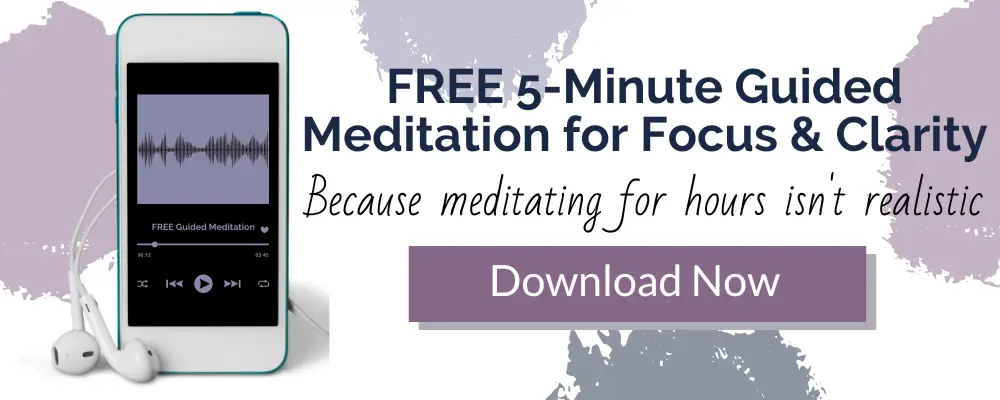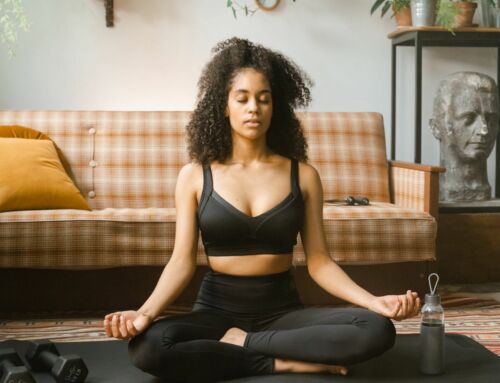Walk Your Way to Mindfulness: The Art of Walking Meditation

If you’re feeling overwhelmed and burned out by the hustle and bustle of daily life, I understand how you feel. The good news is that you don’t have to feel this way forever. As someone who has felt the benefits of walking meditation firsthand, I can say without a doubt that this exercise can help you find calm with the added bonus of not having to sit still and concentrate.
If you’re looking for a way to calm down, and reduce your anxiety this exercise is just what you need. But is it okay to meditate while walking? Walking meditation has been done for thousands of years and is a unique way to practice mindfulness while also getting some exercise. In fact, many people find that walking meditation is even more effective than a seated meditation practice for quieting the mind and reducing stress.
Read on to learn the benefits, how to prepare, how to begin, and how to overcome common obstacles. We will also discuss how to incorporate this technique into your daily routine.
What Is Walking Meditation?
Walking meditation is a form of mindfulness where you focus on being conscious and fully aware of the present moment while walking. It involves paying attention to your surroundings and the sensations you feel as you move.
As we go about our daily lives, we often forget to take a moment to slow down and simply be present. This technique can help us be more aware and focused in our everyday lives.
Benefits of Walking Meditation
When it comes to improving your mental, physical, and emotional health, this exercise has many good things to offer.
Relieve Stress & Anxiety: Studies have shown mindful walking reduces stress and anxiety. by allowing you to slow down and focus on the present moment. When we walk, our mind becomes focused on the present moment, and we’re better able to let go of worries and anxieties. The rhythmic movement of walking, combined with deep breathing, can also promote relaxation and reduce tension.
Improve Heart Health: Improve your cardiovascular health, which can help to reduce the risk of heart disease and lower blood pressure. Walking is a low-impact exercise that can help maintain healthy blood pressure levels and reduce the risk of developing heart disease.
Better Quality Sleep: Improve the quality of your sleep by promoting relaxation, and reducing stress. It’s been shown to increase the production of serotonin, a hormone that regulates mood and sleep.
Improved Focus & Concentration: Improve your focus and concentration by training your mind to be more present and attentive. It can increase awareness, leading to improved cognitive function.
Grounding & Connecting With Nature: Feel more grounded and connected with nature by encouraging you to pay attention to your surroundings. It allows us to appreciate the beauty of our surroundings and experience a sense of calm and peace.
Improve Digestion: Improve digestion by increasing physical activity, promoting relaxation and reducing stress levels that can interfere with proper digestion. Walking after a meal can also aid in digestion by promoting movement in the digestive system.
Overall Improved Wellness: Strengthens bones, improves muscle endurance, and helps to maintain a healthy weight by providing a low-impact form of exercise. Using this exercise regularly can help to improve your physical health and wellness. It’s a gentle and accessible way to improve physical fitness and maintain overall health.
Types of Walking Meditation
There are many styles and forms of mindful walking, each with its unique benefits. Here are some of the most popular types:
Zen Walking Meditation
Also known as kinhin. This exercise is commonly associated with Zen Buddhism. It involves traveling in a circle around a room with other practitioners, usually between periods of longer sitting meditation. The focus is on moving slowly and carefully, paying attention to every aspect of the movement.
Daoist Walking Meditation
A gentle, slow, and continuous exercise that emphasizes, balance and harmony in physical and mental connection. Practitioners walk in a relaxed and natural way, feeling the sensation of the feet on the ground, the rhythm of the breath, and your movement. There are many methods and techniques used including visualization.
Thich Nhat Hanh Walking Meditation
Thich Nhat Hanh is a Vietnamese Zen master who has popularized a simple, yet powerful technique. It involves taking slow, deliberate steps, while breathing in and saying “I have arrived,” and breathing out and saying “I am home.”
You can try it with a guided audio, or on your own. The mantras are taken from a waking meditation by Thich Nhat Hanh. The full poem is below:
I have arrived. I am home.
In the here. In the now.
I am solid. I am free.
In the ultimate I dwell.
Theravada Walking Meditation
Also known as chaṅkama. This is a tradition that comes from Theravada Buddhism. This technique focuses on building concentration and focus. Practitioners walk back and forth along a straight path, focusing on the movement of the feet and the sensations they feel, and maintaining focus throughout. It’s often used as a complement to sitting meditation.
Labyrinth Walking
Labyrinth walking involves following a winding path that leads to the center of a pattern or design. It is a symbolic journey that represents the path of life and can be used for relaxation, introspection, and problem-solving.
Forest Bathing or Shinrin-Yoku
Forest Bathing, or Shinrin-Yoku, is a Japanese technique that involves immersing oneself in nature and using all of the senses to connect with the environment. Strolling slowly through the forest, breathing in the fresh air, and feeling the natural surroundings can be a powerful way to reduce stress and improve overall well-being.
No matter which technique you choose, the key is to walk consciously, pay attention to your breath, and your surroundings. Experiment with different styles and see which one resonates with you the most.
How to Prepare for Walking Meditation
To get the most out of this technique, it’s important to prepare yourself and your environment beforehand. Here are some things to keep in mind:
Choosing the Best Location
The first step in preparing is to choose the right location. Look for a place that is quiet and peaceful, such as a park or a forest trail. You want to find a place that is free from distractions, so you can fully immerse yourself. It’s also important to choose a location where you feel safe and comfortable.
Choosing the Best Time
Find a time when you won’t be interrupted, and when the weather will be nice. Some people prefer early in the mornings when most people are still sleeping, while others prefer the evening as a way to wind down from the day. It’s important to choose a time that works for you and your schedule.
Wear Comfortable Clothing and Shoes
It’s important to wear comfortable clothing and shoes. Loose-fitting clothing allows you to move freely and breathe deeply. Choose comfortable shoes that provide support and cushioning for your feet. Avoid tight clothing that may restrict your movement or breathing.
Set Intentions
Before you begin, take a few moments to set your intentions. Ask yourself why you are trying this exercise, and what you hope to gain. This will help you to stay focused and motivated. Some common intentions include reducing stress, improving focus, and connecting with nature.
How to Practice Walking Meditation
Now that you’re prepared, it’s time to get going with this simple and accessible exercise that can be done anytime, anywhere. Here are some steps to begin:
1. Choose A Location
Choose a quiet, safe, and peaceful place to walk. It could be a park, a forest trail, or a quiet neighborhood street. You can choose a circular path, or simply walk back and forth along a straight line.
2. Take A Deep Breath
Take a few deep breaths and allow your muscles to relax as much as possible. Relax your hands, arms and shoulders, let them hang naturally by your sides. Let your arms swing naturally at your sides, and relax your hands and shoulders.
3. Start Walking
Begin slowly and consciously, at a comfortable pace. Pay attention to each step. Make sure to stand tall and straight, with your shoulders relaxed.
Let your arms swing naturally at your sides, and relax your hands and shoulders. If you’d rather keep your arms still you can clasp your hands behind your back, keep them at your sides, or in front of you.
4. Soften Your Gaze
Soften your gaze. Instead of looking straight ahead, soften your gaze and allow your peripheral vision to expand. This helps to minimize distractions and allows you to focus on your internal experience.
5. Pay Attention To Your Steps
Focus your attention on the sensation of your feet touching the ground with each step. Feel the contact between your feet and the earth, the shifting of your weight from one foot to the other, and the movement of your legs.
Pay attention to your speed and make sure you’re keeping a slow, intentional pace. Slow and steady is best. If you find yourself rushing or moving too quickly, slow down and bring your attention back to your breath and your steps.
6. Pay Attention To What You Feel
As you continue, pay attention to any sensations you feel as you walk. Notice the warmth of the sun, the feeling of clothes against your skin, or the sensation of the wind on your face.
As you walk, relax your hands, arms, and shoulders. You may want to roll your shoulders back and down a few times to release any tension.
7. Notice Sounds and Smells
Be aware of any sounds or smells around you. Hear the rustling of the leaves or the sound of birds singing. Smell the flowers or the fresh air. Pay attention without getting caught up in them.
8. Don’t worry if your mind wanders
Don’t worry, it’s natural for your mind to wander. When you notice your mind getting distracted, gently bring your attention back to your breath and to the sensations of your feet touching the ground.
You can use the rhythm of your steps as an anchor to bring your mind back to the present moment.
9. Practice
Continue for as long as you like, whether it’s for five minutes or an hour. When you’re practicing walking meditation make sure you enjoy the experience.
With time and repetition, you’ll find that you’re able to maintain a sense of calm, focus and relaxation throughout your day.
This is a very versatile technique that can be adapted to your needs and preferences. You can experiment with different postures, breathing techniques, or visualization exercises to find what works best for you. Remember, the key to success is to stay focused on the present moment, and to maintain a sense of curiosity, openness, and kindness.
Overcoming Obstacles
Learning conscious movement can be a peaceful and restorative, but it’s not always easy. It can be challenging at times to stay focused, but with repetition, you can overcome common obstacles that may come up. Here are some tips for overcoming common obstacles:
Handling Distractions
Distractions are a natural part of the process. If you find your mind wandering or getting distracted, gently bring your focus back to your breath or your steps.
You can also try a recorded guided walking meditation to help you focus. A guided meditation can help give your brain another point of focus.
Don’t get discouraged or judge yourself for getting distracted; instead, use it as an opportunity to bring your attention back to the present moment.
Physical Discomfort
If you experience discomfort, such as pain in your feet, legs, or back, pause and take a moment to adjust your posture or stretch. Try to find a balance between challenging yourself and being kind to yourself. Try using progressive muscle relaxation before or after your walking to help you relax and let go of tension.
Difficult Emotions
If you begin to experience difficult emotions, try to acknowledge them without judgment and bring your attention back to your breath and your steps.
Taking the time to quiet your busy thoughts can allow strong emotions to come to the surface, such as anxiety, anger, or sadness. If you experience difficult emotions, acknowledge them and try to observe them without judgment. Use your breath or your steps as an anchor to help you stay present and grounded. If needed, take a break and try again later.
Making Walking Meditation A Habit
This exercise can become a powerful way to cultivate peace and focus in your daily life. Here are some tips for incorporating it into your routine:
Set Aside Time Every Day
Try to set aside a specific time each day. Make it a non-negotiable part of your schedule so you don’t try to wiggle out of it. Whether it’s a few minutes in the morning or a long walk in the evening.
Habit chaining can also be a powerful tool. Try setting your scheduled time right next to another habit that you already do every day. That way the habit you already have reminded you to incorporate this new habit. For example, if you have a cup of coffee every morning. Head out right after that cup of coffee, or even take it with you.
Find Opportunities Throughout the Day
Look for opportunities for movement. You don’t need to have a lot of time. You can incorporate it into your daily routine by taking a conscious walk during your lunch break or while doing household chores.
Combine With Other Techniques
Walking meditation can be combined with other exercises, such as deep breathing, or visualization exercises. Here are some tips for combining with other exercises:
-
Focus on the breath: You can focus on your breath, inhaling deeply and exhaling slowly. This can help you stay present and focused on the moment.
-
Use mantras: You can also use mantras or affirmations, repeating phrases like “I am present” or “I am at peace.”
-
Body scan: You can do a mental check from head to toe, paying attention to any sensations of tension or discomfort releasing each area as you go.
Try it For Yourself
Now that you’ve learned all about moving meditation it’s time to give it a try. Remember, learning anything new takes time and patience. Be kind to yourself and enjoy the journey.
This technique can be a great addition to your practice. It’s a simple and accessible way to cultivate a greater sense of awareness, presence, and connection with the world around you. It’s a powerful tool that can help you live a more fulfilling and present life. For information on other types of meditation like candle gazing, progressive muscle relaxation, or visualization check out my article Unlock Calm With 10 Mindfulness Meditation Exercises.














